2022.10.26
British Columbia’s tallest Passive House project, 825 Pacific Passive House is the first arts and culture hub in Canada to achieve the stringent performance standard.
Cascadia Windows & Doors was recently recognized with a 2022 Silver Award by the Vancouver Regional Construction Association (VRCA) for the company’s work on 825 Pacific Passive House. In its 33rd year, the award recognizes projects from across metro Vancouver in the categories of environment, sustainability, and heritage.
“We’re very proud to be a recipient of the VRCA 2022 Silver Awards,” says Mike Battistel, president of Cascadia Windows & Doors. “It’s fantastic to see so many innovative, high-performance buildings being recognized and celebrated.”
Featuring over 3,500 square feet of Cascadia’s award-winning Universal Series™ Passive House certified windows, the seven-story 825 Pacific Street Passive House project is the tallest Passive House certified building in BC, and the first Passive House certified arts and culture hub in Canada.
Owned by the City of Vancouver and designed by IBI Group, with Ledcor Construction acting as general contractor, the all-electric, near-zero-emission facility provides affordable rental space to artists and cultural nonprofits.
“It’s exciting to see multi-family and commercial Passive House projects start to gain traction in markets across North America,” says Battistel. “As cities and consumers look to reduce the environment impacts of buildings—and just make buildings more comfortable—Passive House is really coming into the mainstream.”
Recent projects such as the University of Victoria (UVic) student residence & dining hall, the Gastown Childcare Centre in Vancouver and the Ken Soble Tower EnerPHit project in Hamilton, Ontario, are all Passive House projects making international headlines. But the increase in Passive House projects didn’t happen overnight.
“There’s been a concerted effort by manufactures, multiple levels of government and industry associations to help educate and promote the Passive House approach,” explains Battistel. “Associations like Passive House Canada have done a great job of education and advocacy within the construction industry, while community groups like Passive House Accelerator have brought together thousands of people interested in creating more efficient buildings.”
But it’s not just the efficiency that’s driving the shift towards Passive House buildings—it’s also the costs.
“As knowledge about Passive House projects has increased, costs to build these high-performance buildings have been falling,” says Battistel. “If you take a holistic approach to building performance—not just a line-by-line view—you can not only get better value for your money, but you can save up to 90% on operating costs of that building.”

